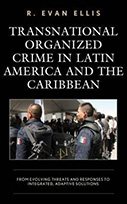Transnational Organized Crime In Latin America And The Caribbean: From Evolving Threats And Responses To Integrated, Adaptive Solutions

Author: R. Evan Ellis
Publisher: Lanham, MD: Lexington Books, 2018. 236p.
Reviewer: Frederick T. Martens | September 2020
Author R. Evan Ellis, professor of Latin American Studies at US Army War College (and previously at the Center for Hemispheric Defense Studies) focuses his discussion of transnational organized crime on the relationships between and among the United States, Latin America and the Caribbean, arguing that the danger organized criminal networks pose in the region is “little understood and undervalued.” Based on his experience and research, including interviews with regional military and law enforcement practitioners, Ellis maintains that “the centrality of public insecurity and the struggle against transnational organized crime” is the primary strategic threat to the Western Hemisphere.
Ellis provides readers an overview of transnational organized crime in Latin America and the Caribbean in five succinct chapters (Introduction; Geography of Transnational Organized Crime; Transnational Organized Crime Groups; Comparative Solutions; The Path Forward). The book addresses relationships between source, transit, and consumption zones of narcotrafficking, and touches upon other illicit activities such as human smuggling, money laundering, contraband, and illegal mining. Together, the chapters detail how transnational organized crime feeds off an increasingly inter- and intra-connected global economy and subverts its functioning. The biproducts of violence, corruption and distrust in social institutions that are generated ultimately undermine each country’s security, governance and prosperity. Regional governments’ efforts at combatting transnational criminal networks have yielded uneven results, giving Ellis an opening to argue against desperate, short-term measures and for “persistent, adaptive and effectively sequenced” strategies coordinated across government agencies. A broader, collaborative approach must include all partners in the region working to find solutions to shared problems. Unfortunately and oddly, Haiti and Cuba are omitted from the analysis. The manuscript is heavily footnoted, and references are primarily from (English language) security/military sources, material criminologists often overlook.
Rather than serve as a scholarly or theoretical treatise, the book’s intent is to provide regional colleagues ideas for combatting the shared challenge of transnational organized crime. Of interest to criminologists is Ellis’ recognition that the problems of transnational crime cannot be solved by repressive measures alone, which he admits are often counterproductive and lead to additional violence and criminality. Instead, he argues for strengthening economic, social and governmental institutions in order to disrupt the corruption that allows criminality to spread. Ellis provides a thorough analysis of holistic, multidimensional and integrated solutions even as he acknowledges that available resources and the ability to coordinate said resources varies widely by country. As a result, intelligence and security practitioners need to be particularly strategic and flexible. (Of interest is Ellis’ finding that the formerly distinct roles assigned to militaries and police are outdated in an era where borders are less relevant to security).
The Transnational Organized Crime Groups chapter summarizes prior studies and questions some definitions of the term. For example, he questions the classification of groups that operate within their respective borders servicing the needs of cross-border or transnational groups, and whether transnational crime networks must have as a goal the pursuit of “power and influence”. Ellis is able to discuss disparate organizations that have in common only criminal activity by presenting a new typology of cartels, intermediary groups, ideologically oriented groups, and gangs. The author further notes the variability and mutability of transnational organized crime groups. Aligned with the research of criminologists Steffensmeier and Martens (2002) Ellis finds that “…if there is one almost universal characteristic…it is they seldom persist in one form for more than a few years.” The Comparative Solutions chapter provides recommendations in eight key areas: whole of government solutions; interdiction of criminal flows; targeting transnational organized crime leaders; targeting financial flows and resources of transnational organized crime groups; using military in domestic law enforcement; institutional reform in policing; prison control and reform; and bi-national and multi-national cooperation. Of these, military use in domestic law enforcement and institutional reform in policing and in prisons may be especially important for US policymakers to understand about the region when seeking to develop any kind of holistic approach to counter transnational organized crime.
Ellis takes positions that some criminologists might contest. For one, the author promotes drug interdiction by “attacking it at its source” (p. 175) despite available evidence that demand drives supply, and risk outweighs the probabilities of punishment. This is the conundrum of prohibition policy, one that is lost on policy makers who believe that the state can arrest its way out of an intractable and immutable problem. Even as Ellis acknowledges the violent consequences often associated with arresting and incarcerating leaders of drug cartels, he calls upon practitioners to improve the “anticipation and management of collateral effects in targeting criminal group leadership” in order to minimize the violence; by analyzing possible effects and preparing for them lives may be saved.
The author also contends that “because of the level of control associated with the sophisticated financial infrastructures of demand zone economies like the US, and the relative absence of an informal sector, the money generated is rarely laundered there (p. 14). Prior research, however, indicates that oftentimes the United States is actually a preferred safe haven for laundered monies from foreign jurisdictions as well as from the domestic underground economy. Particularly in the luxury real estate market, which is not subjected to the laws on money laundering, racketeers, oligarchs, drug traffickers, and gangsters have found this “launderette” to be both safe and often anonymous. (Reuter, 2004; Story, 2015).
Finally, a primary contribution is Ellis’ discussion and promotion of a “whole-of-government” agenda that recognizes that arrests, prosecutions, and incarceration will not contain transnational organized crime. He calls for approaches that “address the range of enabling conditions” including poverty, inequality, and the vulnerability of youth. Such holistic and integrated approaches require states to work with communities to strengthen relationships and build trust. But public policy proclamations are meaningless when funding is scarce and political will is muted or absent. Regrettably, Ellis provides no credible plan to address the optimum ratio of enforcement to (1) educate the young so that they can escape the chains of poverty; (2) establish job programs that narrow the inequality separating the haves from the have-nots; (3) rehabilitate systemically-corrupt political and civil institutions; and (4) ends the blatant violence that usurps the power of the state whose task it is to ensure domestic tranquility (Whelan, 2018).
Ellis emphasizes greater intra- and inter-government cooperation, an argument that only has currency when the institutions of government are legitimate or perceived as legitimate. Investing in what are disproven and ineffective strategies, as Ellis suggests, has never resulted in any discernible impact. Transnational organized crime is a system that exploits and takes advantages of opportunities created by legislative prohibitions that serve the interests of both the political elites of the corrupted institutions and those willing to take the risks associated with accumulating both political power and wealth. Unless and until we address these prohibitions and the corrupt institutions in ways that mitigate the harms incurred, transnational organized crime will remain a global threat. Ellis’s “Path Forward” represents “more of the same,” with too many lives ruined or wasted as a result.
Reuter, P. and Truman, E. (2004). Chasing dirty money: The fight against money laundering. Washington, D.C.: Institute for International Economics.
Steffensmeier, D. and Martens, F. (2002). “Crime: Organized.” Encyclopedia of social and behavioral sciences. Vol. 3.15. Article 33. Elsevier Sciences, Ltd.
Story, L and Saul, S. (2015). “Towers of secrecy: Piercing the shell companies.” The New York Times. February 7.
Whelan, R. (2018). “Why are people fleeing Central America? A New breed of gangs Is taking over.” Wall Street Journal. November 2.
Frederick T. Martens is the former President of the International Association or The Study of Organized Crime (IASOC) and has spent a career investigating organized crime in New York, New Jersey and Pennsylvania.


